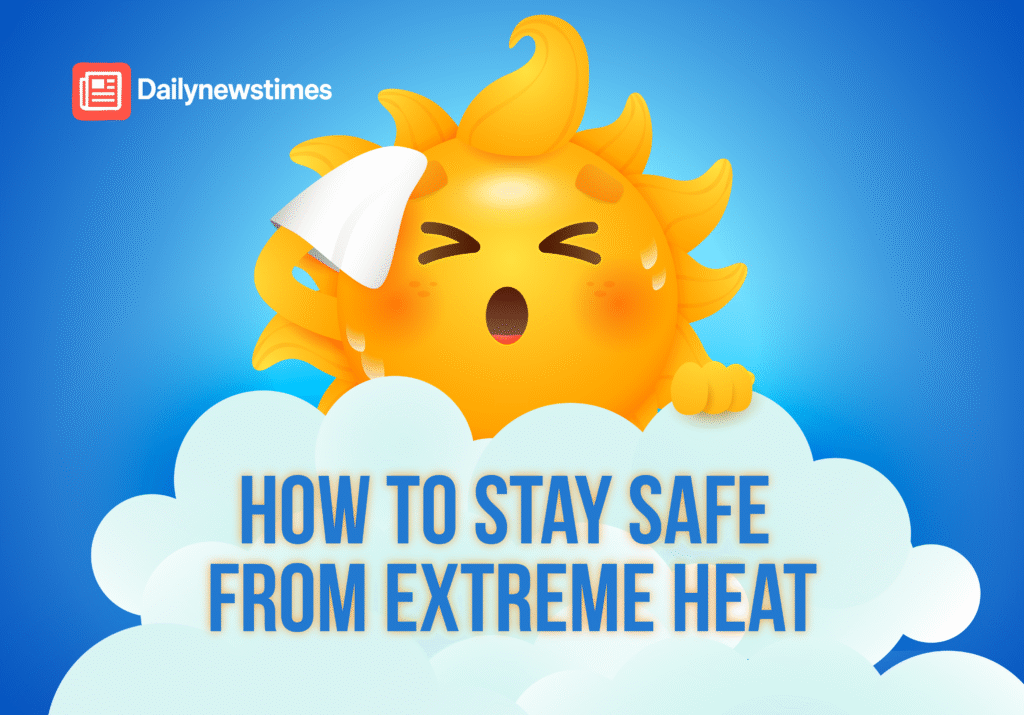Extreme heat aint just about feeling hot.. it’s actually one of the deadliest weather events, especially in United States, where summer heatwaves is getting more dangerous each year. People often think it’s only uncomfortable, but extreme temps can harm your body seriously. If you don’t kno what to do, you can get real sick, fast. This guide will share how to stay safe from extreme heat in a practical way, no fancy talk, just real tips that can save lifes.
Why Extreme Heat Is Getting So Bad
Climate change, it’s making summers hotter than ever before.
- Heatwaves are now more frekwent and long-lasting, specially in states like Arizona, Texas and Nevada. According to Time, extreme heat kills more Americans every year than floods or hurricanes.
- Over 1,300 people in U.S. die from heat-related issues yearly. And dat number is climbing, according to Health.com.
- It aint just old folks, kids and outdoor workers at risk—anyone can get heat stroke if they’re not carefull.
Staying Cool and Safe in Heat
Stayin’ cool sounds simple, but ther’s a lot people forget or just don’t kno.
Cool Down Your Environment
- Use air conditioning if you have it. Fans might not help once temp gets over 90°F (Ready.gov).
- Don’t got AC? Go to cooling centers, like public libraries or community halls. Many cities in U.S. offer them free of cost (Wikipedia).
- Take cold showers, put wet cloths on wrists, neck or ankles, or sit in front of fan with misting water.. It help more than you think.
Dress Right
- Wear loose-fittin’, light-colored clothes. Tight or dark clothes trap heat and sweat, making it worse (CDC).
- Always wear a cap or sunhat, and use sunscreen (at least SPF 15). Sunburn make it harder for your body to cool down (EPA).
Drink Like It’s Your Job
- Don’t wait till youre thirsty. By then, you’re already dehydrated. Drink water regularly (Wikipedia).
- If you sweat a lot, replace lost salts too—sports drinks work, but avoid soda or too much coffee.
- Eat light. Big meals can raise your inside temp. Go for fruits, salads, or soup that got water in them (Heat.gov).
Changing Your Daily Routine
Plan Smarter
- Do outdoor stuff in morning or after sunset. From 10AM to 4PM, the sun’s blazing and risk is high (VA.gov).
- Use HeatRisk tool to check risk levels each day and adjust plans.
Build Tolerance
- Outdoor workers shouldn’t jump into full shifts in heat. It takes like 1–2 weeks to get your body used to it (Wikipedia). Start slow, increase work little by little.
Help Others Too
- Check on old folks, kids, and anyone sick or living alone. Heat can sneak up on them fast.
- Ask your doctor if your meds increase heat risk. Some do and most people don’t even realise it (CDC).
- Never, ever leave kids or pets in a parked car, even if it’s “just for a minute.” It can be deadly (CDC).
Know When It’s Serious
Heat Exhaustion Signs
- Tiredness, muscle cramps, dizzy, feelin’ sick, sweating a lot. If this happens, get to a cooler place, sip water slowly, and lay down with legs up (CDC).
Heat Stroke (It’s an Emergency)
- If someone stops sweating, gets confused, or passes out, call 911 right away (Time).
- Put ice packs on neck, underarms, and groin, or pour water on them and fan hard. Don’t wait for help—act fast.
- Never give ‘em alcohol or caffeine—makes it worse.
Use the Tools and Alerts
- The new CDC/NWS HeatRisk tool gives color-coded alerts for 7-day periods. Check it before planning anything outdoors.
- Download OSHA Heat Safety Tool app for live heat index, tips, and alerts (Wikipedia).
- Many U.S. cities now have Chief Heat Officers to help communities manage urban heat with trees, shade plans, and emergency responses (Wikipedia).
Real Examples From U.S. Heat Events
- In Laredo, Texas, temps hit 106°F this summer, and officials warned everyone to stay indoors, drink water and check on older folks (LMTonline).
- In Connecticut, workers using cooling sleeves and cold-soaked hats were able to stay cooler by 1°F and lasted longer on job (CT Insider).
- EPA recommends long-term fixes like tree planting and shaded bus stops to fight “urban heat islands.”
Pros and Cons of Staying Cool
| Method | Pros | Cons |
|---|---|---|
| Air Conditioning | Very effective, fast relief | Expensive, uses power |
| Fans & Mist | Cheap, easy, works with wet cloths | Doesn’t work when temps too high |
| Cooling Centers | Free, lifesaving | Might not be near by or open late |
| Cooling Clothes | Great for workers | Need planning, not always available |
| Shade / Trees | Eco-friendly, long-term | Takes time and policy to expand |
Frequently Asked Questions
Can I use fans when it’s 95°F?
Fans can help a little, but they might make things worse if its too hot. Use with mist or go somewhere cool (Time).
What if I got no AC?
Use cool showers, fans with ice, and visit public places with AC like malls or libraries (VA.gov).
How much should I drink?
Drink even if you’re not thirsty. Pale pee is good sign you’re hydrated (Verywell Health).
When should I call 911?
If someone faints, acts confused, stops sweating, or looks flushed, call immediately (CDC).
Wrap Up: Keep Cool, Stay Ready
To wrap it up, knowing how to stay safe from extreme heat isn’t just smart, it’s necessary now more than ever.
✅ Drink water and avoid heavy food
✅ Stay in cool places, even if you gotta go to public ones
✅ Dress loose, light, and shaded
✅ Use apps and tools to check daily risk
✅ Look out for your people — family, pets, neighbors
Don’t wait till the heat hits you hard. Prepare now, stay aware, and help others do the same. The sun ain’t playing no more.


